As a passionate gardener, I always look forward to the changing seasons and the opportunity to transform my outdoor space. While many people associate gardening with spring and summer, I’ve discovered the joy of cultivating a vibrant garden even in the coldest months of the year.
One winter, I decided to experiment with bedding plants that could withstand the chilly temperatures and bring color to my garden. I was amazed by the resilience and beauty of these winter bedding plants, which not only survived the frosty weather but thrived in it.
Key Takeaways:
- Winter bedding plants can add color and life to your garden during the colder months.
- These plants are resilient and can withstand frost and snow.
- Popular winter bedding plants include violas, cyclamen, chrysanthemums, helleborus, and pansies.
- Proper planting and care techniques are essential for the success of winter bedding plants.
- Winter bedding plants can be used in beds, borders, hanging baskets, and containers to create a vibrant display.
The Benefits of Winter Bedding Plants
When it comes to maintaining a vibrant garden during the winter months, winter bedding plants are a gardener’s best friend. These resilient plants not only add a splash of color to your garden, but they also offer a range of benefits that make them a favorite among garden enthusiasts.
One of the biggest advantages of winter bedding plants is their ability to thrive in cold weather conditions. Unlike many other plants that wither away when faced with frost and snow, these hardy plants are specifically adapted to withstand the cold. They can endure the harshest winter climates and continue to flourish, keeping your garden looking stunning even in the depths of winter.
Another benefit of winter bedding plants is their versatility. These plants can fill in gaps in your beds and borders, ensuring that your garden remains full and vibrant throughout the year. Whether planted in containers, hanging baskets, or borders, they bring life and color to outdoor spaces that may otherwise appear dull and barren during the winter months.
Not only do winter bedding plants offer aesthetic benefits, but they also provide practical advantages for cold climate gardening. By choosing winter-flowering varieties, you can enjoy the beauty of blooming flowers even when most other plants have gone dormant. This makes them an excellent choice for gardeners who want to create a seasonal garden that remains visually appealing all year round.
To demonstrate the benefits of winter bedding plants, take a look at the following table:
| Benefits | Explanation |
|---|---|
| Colorful winter gardens | Winter bedding plants add splashes of color to otherwise gloomy winter landscapes, creating a visually striking garden. |
| Filling gaps in beds and borders | These plants help to fill gaps left by plants that have finished flowering or gone dormant, maintaining a full and vibrant garden. |
| Cold weather tolerance | Winter bedding plants are specifically adapted to withstand cold weather conditions, including frost and snow, ensuring their survival even in harsh climates. |
| Extended flowering season | By choosing winter-flowering varieties, gardeners can enjoy blooms during the colder months and extend the flowering season. |
| Seasonal garden interest | These plants provide seasonal interest and ensure that your garden remains visually appealing throughout the year. |
Winter bedding plants offer a multitude of benefits, from adding color and filling gaps in beds and borders to their ability to tolerate cold weather conditions and extend the flowering season.
By incorporating winter bedding plants into your garden, you can enjoy the beauty and vibrancy of seasonal garden plants even in the coldest months. These resilient plants are an essential part of cold climate gardening, bringing life and color to your outdoor space even during the winter chill.
Top Winter Bedding Plants
When it comes to choosing the best winter bedding plants for your garden, there are several options that can provide beauty and resilience during the colder months. Violas, cyclamen, chrysanthemums, helleborus, and pansies are among the top winter bloomers that can withstand frosty temperatures and add a burst of color to your outdoor space.
Violas are versatile plants that come in a wide range of colors, from vibrant purples and yellows to soft pastels. They are known for their delicate, dainty flowers and are incredibly easy to maintain. Violas are often used in borders or containers and can even be grown indoors in a sunny spot.
Cyclamen is another excellent choice for winter bedding. With its heart-shaped leaves and unique flowers in shades of pink, white, and purple, cyclamen adds a touch of elegance and vibrancy to any garden. These frost-resistant plants are particularly well-suited for hanging baskets, where their cascading blooms create a stunning display.
Chrysanthemums are known for their striking blooms and are perfect for adding a pop of color during the colder months. They come in a variety of colors and sizes, including both large and small flowered varieties. Chrysanthemums are relatively low-maintenance and can tolerate cold weather, making them an ideal choice for winter gardening.
Helleborus, also known as Christmas rose or Lenten rose, is not strictly a bedding plant but serves as an excellent alternative for winter interest. With its elegant foliage and crimson blooms, helleborus adds a touch of drama to any garden. These frost-resistant plants are long-lasting and can withstand even the harshest winter conditions.
Pansies are beloved for their cheerful, “smiling” flowers that come in a wide range of colors. The Strawberry Swirl variety, in particular, is popular for its vibrant blooms with a mix of red, pink, and white hues. Pansies are well-known as winter bloomers and can add a pop of color and charm to your garden beds, borders, or containers.
Comparison of Top Winter Bedding Plants
| Plant | Main Features | Best Suited For |
|---|---|---|
| Violas | Wide range of colors, easy to maintain | Borders, containers, indoor gardening |
| Cyclamen | Heart-shaped leaves, unique flowers | Hanging baskets, containers |
| Chrysanthemums | Striking blooms, variety of colors and sizes | Garden beds, borders |
| Helleborus | Crimson blooms, elegant foliage | Garden beds, borders |
| Pansies | Wide range of colors, “smiling” flowers | Garden beds, borders, containers |
These top winter bedding plants are not only frost-resistant but also serve as a testament to the beauty and resilience of nature during the colder months. By incorporating these plants into your garden, you can enjoy vibrant blooms and add a touch of color to your outdoor space even when the temperatures drop.
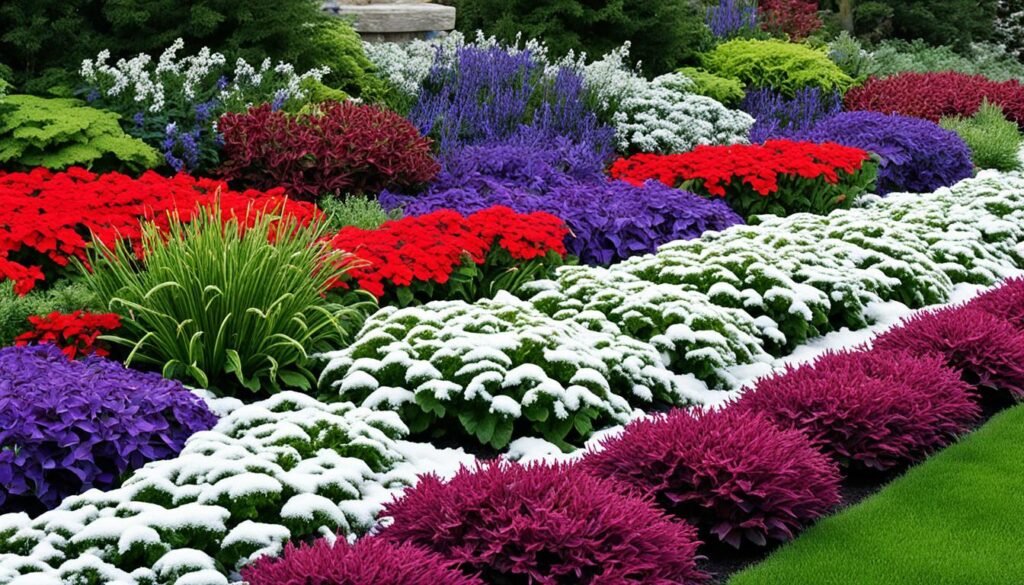
Planting and Care Tips for Winter Bedding Plants
When it comes to maintaining the beauty and health of your winter bedding plants, proper planting and care are essential. By following these tips, you can ensure that your plants thrive even in the harshest winter conditions.
Preparing the Soil
To give your winter bedding plants the best start, it’s important to prepare the soil properly. Begin by removing any old bedding plants from the area. This will help prevent the spread of disease and make room for new growth. Once the area is clear, replenish the soil with fresh compost. This will improve its fertility and provide the necessary nutrients for robust plant growth.
Ensuring Proper Drainage
Good drainage is crucial for the health of winter bedding plants. Excess water can lead to root rot and other issues. Before planting, make sure the area has proper drainage. If you have heavy clay soil, consider adding organic matter or sand to improve drainage. Additionally, avoid planting in low-lying areas where water tends to accumulate.
Regular Watering
Although winter is generally wet, it’s still important to water your bedding plants regularly. Check the soil moisture level frequently and water when it feels dry. However, be careful not to overwater, as this can lead to root rot. Aim to keep the soil moist but not waterlogged.
Deadheading Spent Flowers
Deadheading, or removing spent flowers, is an important task for promoting the continuous blooming of your winter bedding plants. By removing faded flowers, you encourage the plant to produce new blooms. Deadheading also improves the overall appearance of the plants, making your garden more visually appealing.
Additional Care During Dry Spells
While winter is often accompanied by ample rainfall, there may be periods of prolonged dry spells. During these times, it’s important to provide supplemental water to your bedding plants. Pay attention to the weather forecast and water as needed to prevent drought stress.
Remember, different winter bedding plants may have specific care requirements, so it’s always a good idea to research the specific needs of the plants you are growing.
| Planting and Care Tips for Winter Bedding Plants |
|---|
| Prepare the soil by removing old bedding plants and replenishing with fresh compost. |
| Ensure proper drainage to prevent waterlogged soil. |
| Water regularly, but avoid overwatering to prevent root rot. |
| Deadhead spent flowers to encourage new blooms. |
| Provide additional watering during prolonged dry spells. |
By following these planting and care tips, you can ensure that your winter bedding plants thrive and bring color and life to your garden even in the winter months.
Creating a Color Scheme with Winter Bedding Plants
Winter bedding plants offer endless possibilities for creating a vibrant color scheme in your garden. You can mix and match different plants with bold, contrasting colors or opt for a more subtle winter palette. The key is to get creative and experiment with different combinations. These plants can be used in beds, borders, hanging baskets, and containers, allowing you to create a colorful and festive display in your outdoor space.
| Winter Bedding Plants | Color |
|---|---|
| Violas | Purple, yellow, white |
| Pansies | Various colors including yellow, purple, and orange |
| Cyclamen | Pink, red, white |
| Helleborus | Pink, white, green |
Experimenting with Color Schemes
When creating a color scheme with winter bedding plants, consider the overall aesthetics and mood you want to achieve. Here are a few ideas to get you started:
- Monochromatic Palette: Choose a single color, such as purple or white, and use different shades and variations of that color for a soothing and unified look.
- Contrasting Colors: Pair vibrant colors that are opposite each other on the color wheel, such as purple and yellow, for a bold and eye-catching display.
- Complementary Colors: Combine colors that are next to each other on the color wheel, such as pink and purple, for a harmonious and visually pleasing arrangement.
- Warm and Cool Tones: Create a visual contrast by mixing warm-colored plants, like orange pansies, with cool-colored plants, like blue violas.
“The colors of winter bedding plants can evoke different moods and emotions. By strategically combining colors, you can design a garden that feels cozy, lively, or serene.”
Remember to consider the existing elements in your garden, such as the color of your house or fences, and choose plants that complement and enhance the overall visual appeal.
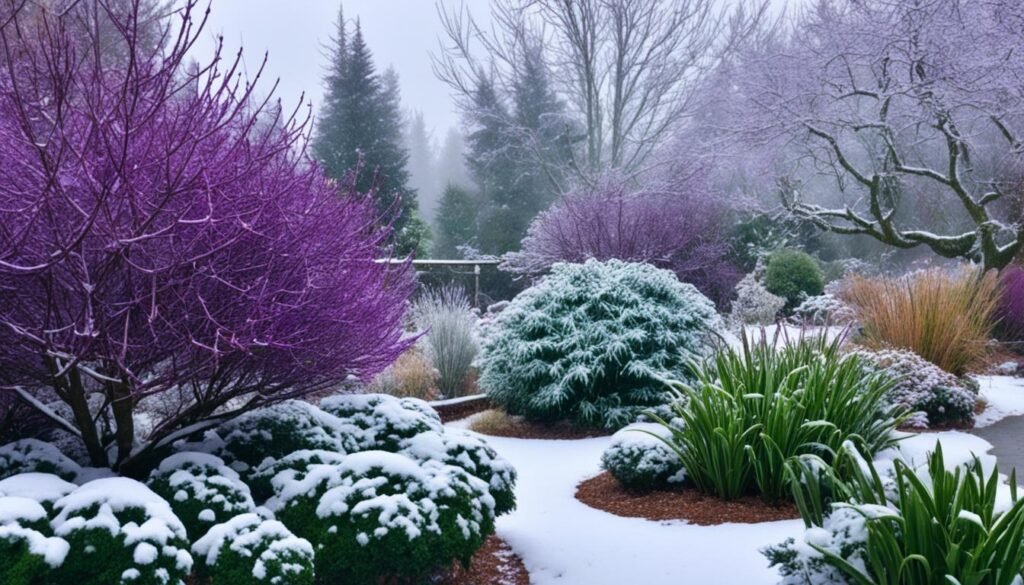
Choosing the Right Winter Bedding Plants for Your Garden
When it comes to selecting winter bedding plants for your garden, it’s crucial to take into account the specific climate and conditions in your area. Not all plants are equally tolerant of cold weather, and some may require additional protection to thrive. To ensure the success of your winter garden, it’s essential to research the hardiness zones of the plants you are considering and choose varieties that are suitable for your region.
By selecting winter bedding plants that are well-adapted to your local climate, you can increase their chances of survival in harsh winter conditions. These plants have developed natural defenses to withstand the cold, such as thicker leaves or specialized root systems. Cold climate gardening requires careful consideration of the plant’s ability to endure freezing temperatures, frost, and snow.
One way to determine a plant’s suitability for your garden is to check its hardiness zone rating. Hardiness zones categorize plants based on their ability to withstand specific temperature ranges. The United States Department of Agriculture (USDA) has established a widely-used hardiness zone map that divides the country into different zones based on average minimum temperatures.
For example, if you live in a region with a cold climate and frequently experience temperatures well below freezing, you would want to select winter bedding plants that are rated for lower hardiness zones, such as zones 5 or 6. These plants have a higher chance of survival in colder temperatures and can withstand the challenging conditions of a colder climate.
Consider the following factors when choosing winter bedding plants:
- Hardiness zone rating: Choose plants that are recommended for your specific hardiness zone to ensure they can withstand the cold temperatures in your area.
- Frost tolerance: Look for plants that are known for their frost-resistant qualities, as they can bounce back after frosty nights.
- Winter bloomers: Select plants that are known for their ability to bloom during the winter months, adding a splash of color to your garden even in the coldest season.
By carefully selecting winter bedding plants suited for your climate, you can create a beautiful and resilient garden that thrives throughout the winter. Whether you opt for vibrant violas, charming cyclamen, or enchanting chrysanthemums, these cold climate plants will transform your garden into a winter wonderland.

Extending the Flowering Season with Winter Bedding Plants
By incorporating winter bedding plants into your garden, you can extend the flowering season and enjoy blooms during the colder months. These plants provide a burst of color and interest when few other plants are in bloom, filling in any gaps left by fading summer flowers. With careful selection and proper care, you can create a garden that remains vibrant and blooming throughout the winter.
Benefits of Winter Bedding Plants
“Winter bedding plants offer a unique opportunity to keep your garden alive and colorful despite the colder temperatures. These plants not only add beauty to your outdoor space but also provide a habitat for pollinators even in the winter months.”
With the extended flowering season, you can enjoy the beauty of blooming flowers during the winter and create a visually stunning garden that stands out all year round. Winter bedding plants are specifically chosen for their ability to thrive in colder temperatures, making them an excellent choice for cold climate gardening.
Winter blooming plants, such as the Violas, cyclamen, chrysanthemums, helleborus, and pansies, are ideal for adding color and life to your garden during the colder months. Their ability to withstand frost and snow makes them a resilient choice for winter gardening. These plants come in a variety of colors and styles, allowing you to create a vibrant and visually appealing garden even when the weather is less than ideal.
Extended Flowering Season Table:
| Plant Name | Flower Color | Height | Blooming Period |
|---|---|---|---|
| Violas | Purple, yellow, white | 6-8 inches | Late fall to early spring |
| Cyclamen | Pink, red, white | 6-12 inches | Winter |
| Chrysanthemums | Various colors | 12-36 inches | Late summer to early winter |
| Helleborus | Various colors | 12-24 inches | Winter to early spring |
| Pansies | Various colors | 6-10 inches | Fall to spring |
By incorporating these winter blooming plants into your garden, you can enjoy a longer flowering season and keep your garden vibrant and alive even during the colder months. The key to success lies in selecting the right plants for your climate and providing them with proper care and maintenance. With a little effort and planning, you can create a winter oasis that blooms with color and brings joy to your outdoor space.
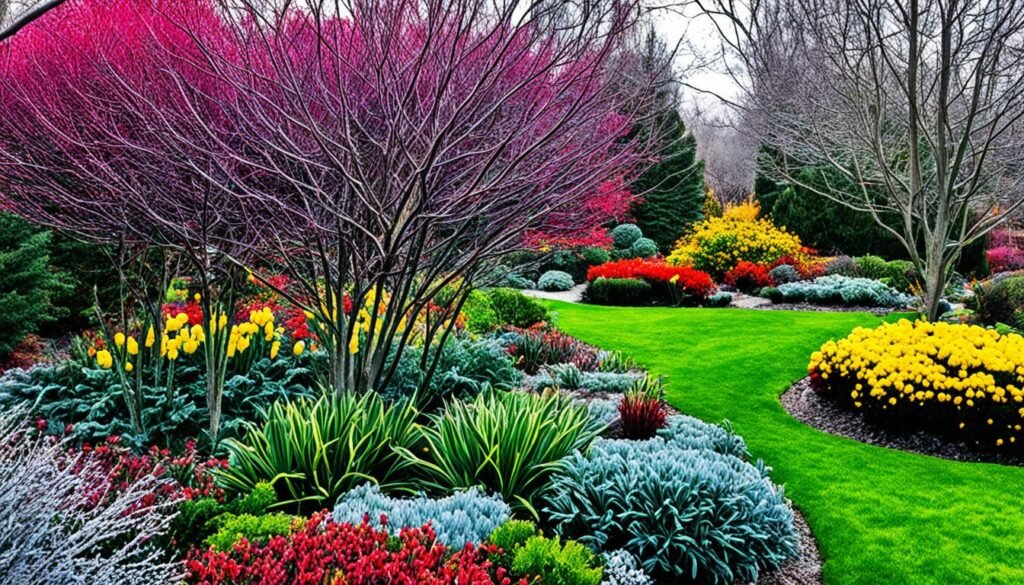
Winter Bedding Plants for Containers and Hanging Baskets
Winter bedding plants are not limited to traditional beds and borders. They can also thrive in containers and hanging baskets, allowing you to add a touch of color and beauty to smaller spaces. Pansies, violas, and cyclamen are excellent choices for winter container gardening. Their compact growth habits make them well-suited for containers, window boxes, and even balconies.
Hanging baskets filled with winter bedding plants can create a warm and inviting atmosphere around your exterior doors. They add a pop of color and a lively welcome for visitors, even in the coldest months. These hanging basket plants can include flowering varieties like pansies and violas, as well as foliage plants like ivy or creeping Jenny for added interest.
To create a stunning display in your containers or hanging baskets, consider mixing different plant varieties to create a multi-dimensional look. Combine plants with contrasting colors, textures, and heights to add visual interest. For example, pair the vibrant blooms of pansies with the delicate flowers of violas and the trailing foliage of ivy.
Remember to choose containers and hanging baskets with adequate drainage to prevent waterlogged roots. Use a high-quality potting mix specifically formulated for containers to provide your plants with proper nutrition and drainage. Water your winter bedding plants as needed, checking the soil moisture level regularly to avoid overwatering.
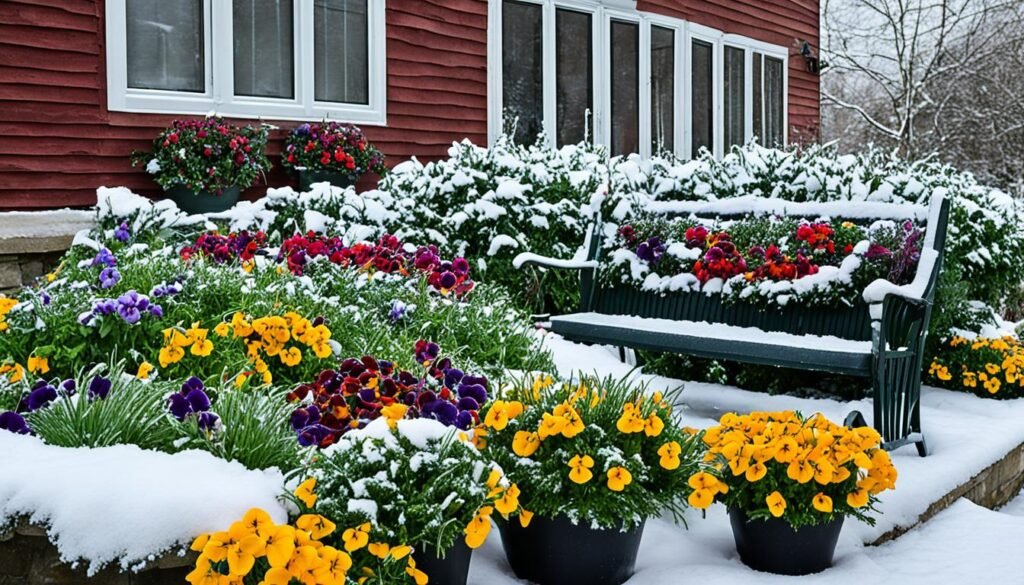
Container gardening and hanging baskets offer versatile options for showcasing winter bedding plants in various locations, from small gardens to urban balconies. With a little creativity and proper care, you can create an eye-catching display that adds beauty and charm to your outdoor space, even during the coldest months.
Winter Planting Guide for Successful Growth
Successful growth of winter bedding plants starts with proper planting techniques. As autumn approaches, it’s essential to prepare your garden for the colder months. Follow these winter planting tips to ensure that your bedding plants thrive and bring life to your garden.
- Remove old bedding plants: Before planting winter bedding plants, remove any old or spent plants from your beds and borders. This will allow for fresh growth and prevent the spread of diseases.
- Prepare the soil: Ensure that your soil is well-drained and enriched with organic matter. Use a garden fork or tiller to loosen the soil and mix in compost or well-rotted manure.
- Choose suitable plants: Select winter bedding plants that are hardy and suited for your region’s climate. Consider plants like violas, cyclamen, chrysanthemums, helleborus, and pansies, which are known for their ability to withstand colder temperatures.
- Provide the right location: Place your winter bedding plants in areas that receive adequate sunlight and are protected from harsh winds. Consider using containers or raised beds if your soil tends to become waterlogged during the winter.
- Water regularly: Winter bedding plants still require regular watering, especially during dry spells. However, be careful not to overwater, as excessive moisture can lead to root rot. Check the soil moisture level before watering and adjust accordingly.
Remember to monitor your plants throughout the winter and provide additional care as needed. By following these winter planting tips, you can ensure the successful growth of your bedding plants and enjoy a vibrant garden even during the colder months.
“The joy of winter gardening is watching your plants bloom amidst the cold. With proper planting techniques, you can create a beautiful winter wonderland in your own backyard.” – Jane Smith, Gardening Enthusiast
| Winter Planting Tips |
|---|
| Remove old bedding plants |
| Prepare the soil |
| Choose suitable plants |
| Provide the right location |
| Water regularly |
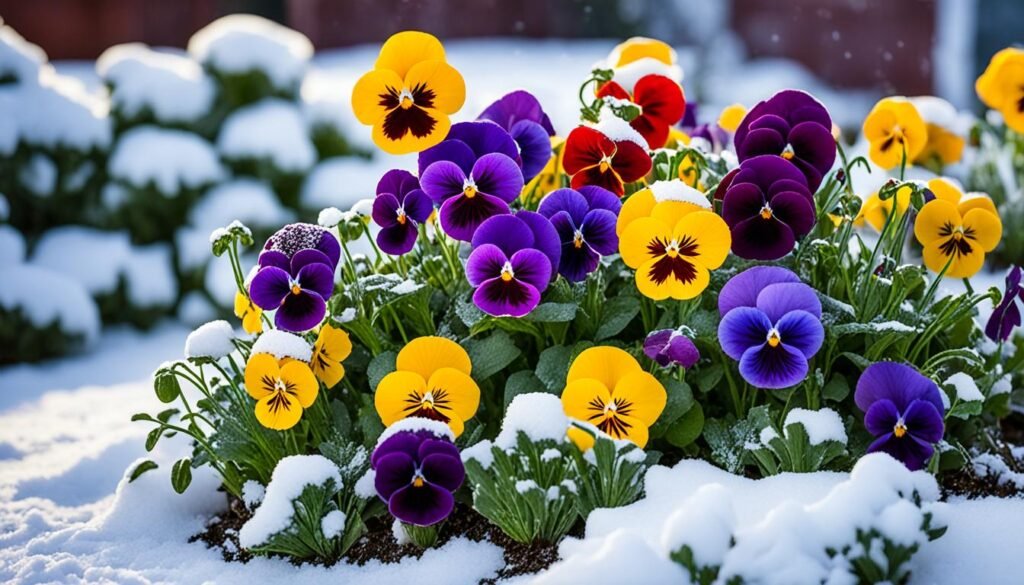
Conclusion
Winter bedding plants are a must-have for any gardener looking to add a burst of color and life to their outdoor space during the colder months. These resilient plants can thrive in cold climate conditions, providing beautiful blooms even in the harshest winter days. Whether you prefer the delicate charm of violas, the vibrant hues of cyclamen, the enduring beauty of chrysanthemums, the crimson blooms of helleborus, or the cheerful display of pansies, there’s a winter bedding plant to suit every taste.
By selecting the right plants and providing proper care, you can turn your garden into a seasonal oasis, brimming with lush foliage and vibrant flowers. These plants are specifically adapted to withstand the challenges of winter, making them an ideal choice for cold climate gardening. With their versatility, they can be used in beds, borders, containers, and hanging baskets, allowing you to create a stunning visual display throughout your outdoor space.
Embrace the variety and beauty of winter bedding plants to ensure your garden remains vibrant and full of life, even during the coldest months. With their ability to withstand frost and snow, these plants will bring seasonal cheer and color to your garden, providing an exquisite visual experience for you and your visitors. So don’t let winter deter your gardening ambitions – explore the world of winter bedding plants and transform your garden into a flourishing oasis all year round.
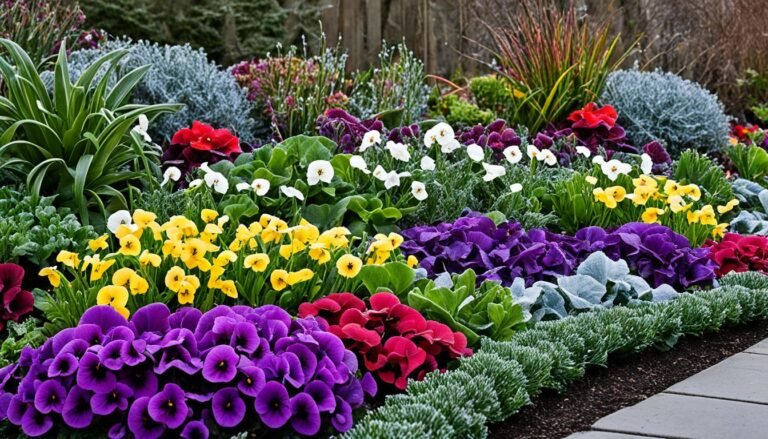
1 thought on “Winter Bedding Plants Guide for a Vibrant Garden”